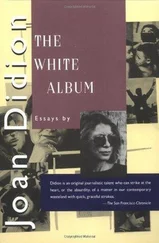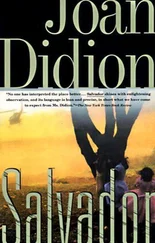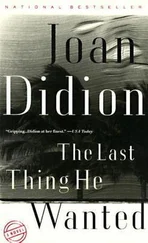Torrance is off the San Diego Freeway, west of Lakewood and south of El Segundo and Hawthorne and Lawndale and Gardena. Canoga Park is in the San Fernando Valley. People who worked for Hughes did in 1988 live in Torrance and Canoga Park. Five years later, after passage by the Arizona state legislature of a piece of tax-incentive legislation known locally as “the Hughes bill,” Hughes was moving a good part of its El Segundo and Canoga Park operations to Tucson, and a well-known residential real estate broker on the west side of Los Angeles was advising clients that the market in Beverly Hills was down 47.5 percent. I remember being told, by virtually everyone to whom I spoke in Los Angeles during the few months that followed the 1992 riot, how much the riot had “changed” the city. Most of those who said this had lived in Los Angeles, as I had, during the 1965 Watts riot, but 1992, they assured me, had been “different,” 1992 had “changed everything.” The words they used seemed overfreighted, ominous in an unspecific way, words like “sad” and “bad.” Since these were largely not people who had needed a riot to tell them that a volatile difference of circumstance and understanding existed between the city’s haves and its have-nots, what they said puzzled me, and I pressed for a closer description of how Los Angeles had changed. After the riot, I was told, it was impossible to sell a house in Los Angeles. The notion it might have been impossible to sell a house in Los Angeles that year for a simpler reason, the reason being that the money had gone away, was still in 1992 so against the grain of the place as to be largely rejected.
The sad, bad times had actually begun, most people later allowed, in 1989, when virtually every defense contractor in Southern California began laying off. TRW had already dropped a thousand jobs. Rockwell had dropped five thousand as its B-I program ended. Northrop dropped three thousand. Hughes dropped six thousand. Lockheed’s union membership had declined, between 1981 and 1989, from fifteen thousand to seven thousand. McDonnell Douglas asked five thousand managers to resign, then to compete against one another for 2,900 jobs. Yet there was still, in McDonnell Douglas towns like Long Beach and Lakewood, space to maneuver, space for a little reflexive optimism and maybe even a trip to Vegas or Laughlin, since the parent corporation’s Douglas Aircraft Company, the entity responsible for commercial as opposed to defense aircraft, was hiring for what was then its new MD-II line. “Douglas is going great guns right now because of the commercial sector,” I had been told in 1989 by David Hensley, who then headed the UCLA Business Forecasting Project. “Airline traffic escalated tremendously after deregulation. They’re all beefing up their fleets, buying planes, which means Boeing up in Washington and Douglas here. That’s a buffer against the downturn in defense spending.”
These early defense layoffs were described at the time as “correctives” to the buildup of the Reagan years. Later they became “reorganizations” or “consolidations,” words that still suggested the normal trimming and tacking of individual companies; the acknowledgment that the entire aerospace industry might be in trouble did not enter the language until a few years later, when “the restructuring” became preferred usage. The language used, like the geography, had worked to encyst the problem in certain communities, enabling Los Angeles at large to see the layoffs as abstractions, the predictable if difficult detritus of geopolitical change, in no way logically connected to whether the mini-mall at the corner made it or went under. It had been August 1990 before anybody much noticed that the commercial and residential real estate markets had dried up in Los Angeles. It had been October 1990 before a Los Angeles Times business report tentatively suggested that a local slowdown “appears to have begun.”
Before 1991 ended, California had lost sixty thousand aerospace jobs. Many of these jobs had moved to southern and southwestern states offering lower salary scales, fewer regulations, and state and local governments, as in Arizona, not averse to granting tax incentives. Rockwell was entertaining bids on its El Segundo plant. Lockheed had decided to move production on its Advanced Tactical Fighter from Burbank to Marietta, Georgia. By 1992, more than seven hundred manufacturing plants had relocated or chosen to expand outside California, taking with them 107,000 jobs. Dun & Bradstreet reported 9,985 California business failures during the first six months of 1992. Analysts spoke approvingly of the transition from large companies to small businesses. The Los Angeles Daily News noted the “trend toward a new, more independent work force that will become less reliant on the company to provide for them and more inclined toward entrepreneurship,” in other words, no benefits and no fixed salary, a recipe for motel people. Early in 1991, the Arco oil refinery in Carson, near where the Harbor and San Diego Freeways intersect, had placed advertisements in The Los Angeles Times and The Orange County Register for twenty-eight jobs paying $11.42 to $17.45 an hour. By the end of a week some fourteen thousand applicants had appeared in person at the refinery, and an unspecified number more had mailed in resumes. “I couldn’t get in the front gate,” an Arco spokesman told the Times. “Security people were directing traffic. It was quite a sight to see.”
According to the Commission on State Finance in Sacramento, which monitors federal spending and its impact on the state, some 800,000 jobs were lost in California between 1988 and 1993. More than half the jobs lost were in Los Angeles County. The commission’s May 1993 report estimated the further loss, between 1993 and 1997, of another 90,000 aerospace jobs, as well as 35,000 civilian jobs at bases scheduled for closure, but warned that “the potential loss could be greater if the defense industry continues to consolidate operations outside California.” The Bank of America estimated six to eight hundred thousand jobs lost between 1990 and 1993, but made an even more bleak projection: four to five hundred thousand more jobs lost, in the state’s “downsizing industries,” between 1993 and 1995. This was what people in Los Angeles were talking about when they talked about the 1992 riot.
PEOPLE who worked on the line in the big California aerospace plants had constituted, in the good years, a kind of family. Many of them were second generation, and would mention the father who worked on the Snark missile, the brother who was foreman of a fabricating shop in Pico Rivera, the uncle who used to get what seemed like half the A-4 line out to watch Little League. These people might move among the half dozen or so major suppliers, but almost never outside them. The conventions of the marketplace remained alien to them. They worked to military specifications, or “milspec,” a system that, The Washington Post noted, provided fifteen pages of specs for the making of chocolate cookies. They took considerable pride in working in an industry where decisions were not made in what Kent Kresa, then chairman of Northrop, dismissed as “a green eyeshade way.” They believed their companies to be consecrated to what they construed as the national interest, and to deserve, in turn, the nation’s unconditional support. They believed in McDonnell Douglas. They believed in Rockwell, Hughes, Northrop, Lockheed, General Dynamics, TRW, Litton Industries. They believed in the impossibility of adapting even the most elementary market principles to the manufacturing of aircraft. They believed the very notion of “fixed price,” which was the shorthand contractors used to indicate that the government was threatening not to pay for cost overruns, to be antithetical to innovation, anathema to a process that was by its own definition undefined and uncertain.
Читать дальше
Конец ознакомительного отрывка
Купить книгу












